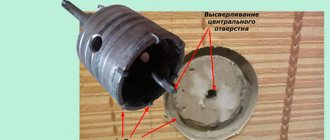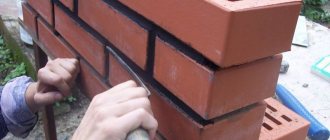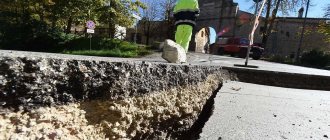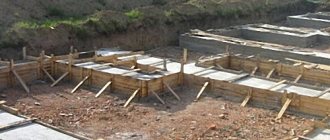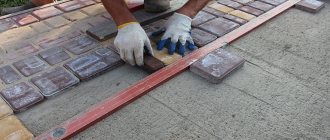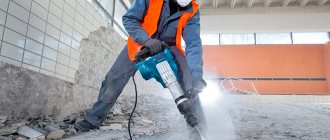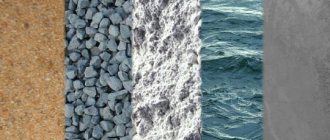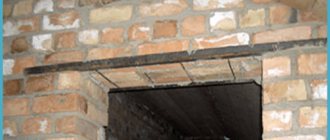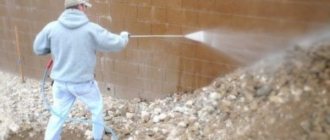How to choose a sealant for joints between concrete and wood?
Various means can be used to seal seams. Corresponding sealants have been created for different materials. They fill joints, prevent the penetration of moisture and cold air, and form a dense layer that is durable and elastic. Before purchasing a sealant, you need to answer the following questions:
- what materials need to be combined;
- where the work will be carried out - outside or inside;
- whether the seam is affected by negative external factors;
- is there contamination at the junction of materials;
- Are the seams going to be painted?
A silicone or acrylate-based sealant is suitable for sealing joints between wood and concrete. Each composition has its own advantages and disadvantages. The first one is highly resistant to moisture, but cannot be painted. The second one is easy to paint, but is not suitable for filling wet joints. Acrylic sealant is most often used for interior work in dry rooms.
Technology for sealing expansion joints
Technological process for installing an expansion joint with sealant:
- curing the laid concrete for a certain period of time (usually 28 days);
- surface preparation (clean, dry, etc.);
- sealing seams with porous gaskets (if necessary);
- applying a primer and letting it sit for a certain period of time (the need to use a primer and its brand must be indicated in the instructions for use of the sealant);
- applying sealant;
- giving the sealant the required shape in the seam.
Belinka sealant range
Our online store offers a large selection of products from the Slovenian brand Belinka. Finishing materials of this brand have an optimal price-quality ratio. There are various sealants available for filling voids:
- Beldom Multiuse is a universal sealant based on MS polymer;
- Beldom Wood - sealing compound for wood;
- Beldom Acryl - acrylic-based mounting adhesive;
- Belsil Universal is a silicone sealant for various structures.
To buy construction sealant, add the selected items to your cart and provide your contact information. Delivery is made throughout Russia. Find out more details from the manager by phone.
Latest articles
Washable paint for interior plastering: properties and application
03.07.2020
Painting outdoor concrete with wear-resistant paint
02.07.2020
Wood treatments to protect against insects
30.06.2020
How to treat plywood to protect it from rotting?
29.06.2020
Treatment of floor joists to protect against moisture and rotting
22.06.2020
Sealant for expansion joints
Expansion joints in underground and above-ground reinforced concrete structures are the most likely places for water leaks.
There are many reasons for this: careless installation of waterproofing materials, poor quality of these materials, incorrect choice of materials, poor design solution, unexpected settlements and deformations of the structure, etc. A complex of materials should be used in expansion joints to ensure their high-quality compaction and sealing:
- sealing mastics (sealants);
- sealing materials;
- tape materials;
- primers;
- thermal insulation materials.
The main materials of the waterproofing element are expansion joints of small movements (2, and for high-modulus ones - with a modulus of more than 4 kg/cm2. The low modulus of elasticity of the material means that after curing the sealant is a soft elastic rubber, which in some cases is important for ensuring a long service life .
Flexibility
Another parameter of important practical importance is the flexibility (elasticity) of the sealing material at subzero temperatures, which is assessed as tensile strength at minimum temperature. This parameter shows how elastic the material remains when strongly cooled and actually confirms the lower limit of the operating temperature range.
Flexibility (frost resistance) is determined by comparing two quantities: the radius of the beam on which the tests are carried out and temperature. A number of companies in their advertisements do not indicate the radius of the beam on which the material was tested. It is clear that the flexibility indicator -20 °C, with a radius of curvature of 5 mm or 20 mm, is far from the same thing.
Types of sealants
Currently, there are a large number of sealants on various bases on the Russian market (bitumen, butyl rubber, polyurethane, silicone, etc.). The use of a particular material is carried out taking into account several factors. In addition to relative elongation (see table), these are the conditions of work at a specific site, operating conditions, seam design, resistance to UV radiation, etc.
— hot curing (bitumens)
— cold curing (rubber bitumen, butyl rubber)
Cool Curing
Curing when solvent evaporates or emulsions break when exposed to air
Selecting a sealant
When selecting a sealant material, one should proceed from the condition that the maximum permissible deformations of the sealant for a given cross-section must be greater than the maximum movements of adjacent structures in the expansion joint.
When sealing expansion joints, it should be borne in mind that, other things being equal, the greater the ratio (shape coefficient K) of the thickness of the sealant to the width of the seam (K=D/W), the greater the stresses it is subjected to.
When the shape coefficient in a sealant joint is equal to or less than one, the best conditions for realizing its elastomeric characteristics are provided. Conversely, the higher the aspect ratio, the smaller the gap in the seam the sealant can provide.
Sealing materials
To seal expansion joints, materials that are elastic and do not adhere to sealants are recommended. In this case, the use of mounting foams is not allowed because They do not have elasticity, have adhesion to the sealant and absorb moisture well.
We recommend polyethylene foam products (gaskets) such as Vilaterm (TU 2291-009-03989419-06) or Tilit (TU 2224-069-04696843-2003) of different standard sizes, which are installed in the seam compressed by 25–50%, and due to their elastic properties together with sealant ensure the tightness of the seam. Polyethylene foam gaskets are also a substrate for the sealant and ensure the creation of the required thickness and configuration of the mastic seam. Polyethylene foam gaskets do not adhere to the sealant and thus ensure its free mechanical operation in the seam.
Polyethylene foam cords are available in a length of 3000 mm in the form of a round section with a hole (outer diameter from 30 to 120 mm) and a solid section (outer diameter from 6 to 80 mm). By agreement with the consumer, polyethylene foam cord is available in other sizes and configurations.
When using hot mastics, it is necessary to lay a heat-resistant cord.
Rigid seals must not be combined with flexible sealants. With an increase in ambient temperature and the inevitable elongation of the mating elements, the cement-sand mortar of the seal is destroyed, wedging into the sealants and violating their integrity, and, consequently, causing depressurization.
Sealants retain their elastic properties (deformability) and adhesive-cohesive strength for a long time if applied to soft elastic gaskets.
Thermal insulation materials
For thermal insulation of expansion joints, insulating liners, sealing gaskets and additionally Vilaterm polyethylene foam gaskets are used, which are installed at the rear of the seam mouth.
Insulation materials should:
- together with sealing materials, provide the required resistance to heat transfer of the seam;
- have a certain elasticity during operation in order to withstand temperature and other changes in the size of the seams without destruction.
Insulating liners are made of mineral wool boards; the use of liners made of polystyrene foam boards is allowed.
Recently, the material for filling the seam cavity has been TECHNONICOL XPS extruded polystyrene foam, which is placed into the seam during its formation during the concreting process, which ensures free compression and opening of the seam with virtually no stress on the mating elements. At the same time, it does not absorb water and is strong enough to withstand the loads of freshly laid concrete, which is very important when carrying out concrete work.
Expansion joint in concrete floors
Home|Useful articles|Expansion joint in concrete floors
Date: November 28, 2017
Comments: 0
An integral part of construction activities for the construction of warehouses, manufacturing plants, stations, terminals, shopping centers and other facilities is the installation of concrete foundations. Such floors can withstand significant loads and abrasive effects. To increase the service life and prevent the appearance of cracks, expansion joints are made in concrete floors. They are special technological grooves that reduce the load on the base.
Why is an expansion joint performed in concrete floors?
According to the requirements of the design documentation, making technological cuts of concrete foundations is a mandatory measure. Despite its ability to withstand significant compressive forces, concrete is a rather brittle material. Under the influence of plastic deformations, the concrete base does not deform, like plastic, which has increased ductility. Concrete loses its integrity, cracking like glass.
An expansion joint is a technological cut in a concrete floor that reduces the effective forces on the coatings and nearby architectural structures
The formation of cracks is caused by the following factors:
- acting loads exceeding the strength of the material;
- internal stresses arising in the concrete foundation;
- temperature changes characteristic of a particular area;
- shrinkage deformations associated with uneven hardening;
- settlement of the building caused by soil pressure on the foundation of the building;
- soil reaction to a floor poured directly onto the soil;
- sharp fluctuations resulting from seismic phenomena.
Cutting deformation grooves allows you to minimize the impact of these negative processes and ensure the integrity of the floor.
Requirements of building codes and regulations for deformation cuts
The provisions of the current regulatory documents regulate the parameters of seams related to a number of factors:
- temperature fluctuations for a specific region;
- brand of concrete used to fill the floor;
- thickness of the monolithic base;
- the magnitude of the mechanical impact;
- area of the poured base.
Depending on the functions performed, expansion joints are divided into several types
The main requirements are specified in the current building codes and regulations:
- grooves must be made in all types of premises where temperature fluctuations from positive to negative values are possible;
- the location of the channels must correspond to the coordinates of the column axes and the gaps between the reinforced concrete floor panels;
- sealing of cavities should be carried out with special polymer compositions with increased ductility;
- the interval between deformation sections should be 8–12 m for foundations reinforced with steel reinforcement;
- Individual calculation of the distance between the cavities should be carried out depending on the thickness of the monolith and the specific operation of the floor.
It is important to pay attention to the following points:
- perpendicularity of the location of the cuts. This will compensate for the deformation of the array and prevent the formation of cracks;
- compliance of dimensions with the requirements of design documentation. The depth of the grooves should be 25-30% of the thickness of the screed;
- timely formation of grooves. When making cuts in a hardened base, cracks may form and material may fall off along the edges;
- compliance with the dimensions of the breakdown, as a result of which areas are formed that are as close as possible to a square shape. T-junctions should be avoided;
- ensuring the correct distance between grooves. The interval should be 24–36 times the thickness of a standard screed.
Compliance with the provisions of SNiP guarantees the integrity of the concrete floor.
Expansion joints are made not only in concrete floors, but also in buildings, thereby eliminating the possibility of deformation or destruction of the integrity of structures
Types of special grooves
Depending on the functions performed, there are different types of deformation cuts:
- insulating. They are formed along the perimeter of the walls, along the contour of the foundations for installing equipment, as well as around supporting structures. The seams are designed to eliminate the force impact of the structural elements of the building on the screed. In addition, they make it possible to compensate for the shrinkage of the concrete mass when the volume decreases during the hardening process. The configuration of the insulating grooves located along the perimeter of the columns can be radius or square. To ensure the integrity of the screed, it is important to withstand the angular displacement of the square seam by 45 degrees relative to the column;
- shrinkage This type of groove allows you to compensate for internal stresses that cause cracking of the concrete mass. Shrinkage grooves form weakened zones in the screed, in which cracks form as the concrete hardens. The formation of seams can be done with special strips installed in plastic concrete, as well as by cutting hardened concrete. The depth of the cut does not exceed a third of the thickness of the screed, and the length of the side is from 3 to 6 meters. This allows you to form weakened zones in advance and relieve stress on the monolith in certain areas;
- structural. They are carried out at the boundaries of areas concreted at different times. When concreting larger areas, it is not always possible to pour the entire area during the working day. During stops associated with the delivery of additional volume of the mixture, the previously poured concrete gradually hardens, gaining strength. It is in such areas that structural seams are installed. The distance from the grooves to other types of cuts should be more than one and a half meters. This type of seam works similarly to shrinkage seams, compensating for minor horizontal displacements.
When forming grooves, builders are guided by the requirements of the project, taking into account the actual conditions of the work.
During hardening, concrete can reduce its original dimensions, as a result of which internal stresses appear
Installation of expansion joints in concrete floors
The technology regulates the possibility of performing deformation channels at various stages:
- when concreting the floor. After pouring and sanding the floor, in the area where the groove is located, a strip treated with anti-adhesive material is installed. It is easily removed after the concrete hardens and then seals the grooves with sealant;
- on a ready basis. To make cuts on a frozen floor, special units equipped with diamond discs are used. The technology provides for the possibility of making cuts two days after concreting.
When cutting dry concrete, or when removing slats from a hardened base, it is important to ensure the integrity of the edges.
Using the example of making a groove in hardened concrete, we will determine the sequence of work:
- Mark the surface.
- Adjust the equipment to the required depth.
- Cut a test seam and check the quality of the work performed.
- Continue cutting grooves using the established equipment.
- Form the grooves, following the pouring sequence.
- Seal cavities with caulk.
Work can be carried out 2-3 days after finishing the surface treatment. When cutting seams, it is important to pay attention to the integrity of the edges and maintaining a constant depth equal to 30% of the thickness of the screed.
Expansion joints are required in all rooms where temperatures can change from positive to negative values
Selecting a sealant for expansion joints in concrete floors
It is important to protect finished seams from moisture, debris and aggressive substances. For this purpose, silicone sealants consisting of one or two components are used. The first type is easier to use, and the second type has improved performance properties.
The type of sealant used depends on the following factors:
- effective loads;
- operating conditions.
The sealant must have the following characteristics:
- hardness, thanks to which the geometry of the edges is maintained and their chipping is prevented;
- plasticity, allowing to reliably protect the seam during concrete shrinkage or temperature changes.
Before applying sealant, it is important to thoroughly clean the cavity of debris and dust using compressed air, a brush or a sandblaster.
Let's sum it up
By making deformation channels, you can increase the strength of the floor and significantly extend the service life. It is important to follow the technological recommendations for floor installation, as well as to form the cuts correctly. They will help prevent cracking. When performing work, remember to comply with safety requirements.
pobetony.ru
Methods for sealing seams
Sealing the seams allows you to protect the seams from the penetration of aggressive media and water, and from clogging. Sealing cracks on cement floors allows you to strengthen the screed and protect it from mechanical chips at the joints, prevents tears, punctures, and abrasion. This is especially important if you plan to lay clay tiles on a cement floor, since leaky seams will cause cracks in the covering, which will lead to rapid destruction of the tile covering.
Various materials are used to seal expansion joints:
- Sealing harness. The current method of sealing expansion joints in a cement floor is to lay a sealing band made of polyester foam. This material is quite convenient to use and retains high elasticity, even at low temperatures.
- Sealant for cement floor joints. A very popular option is the use of various sealing mastics. After curing, the material becomes elastic and seals the seams from water. The surface where the cracks were treated with sealant will not be a source of dust.
- Waterstops. Another method is to use a sealing material based on PVC, rubber or cellophane. The material used is profiled tapes called waterstops, made of polymer materials, which are placed inside the expansion joint when pouring cement mortar.
- Profiles for expansion joints. The last way to install expansion joints in a cement floor is to use a profile for expansion joints, which is made up of frost-resistant rubber and aluminum or iron guides. The sealing rubber does not allow dirt and water to pass into the seam. Installing such profiles allows you to reduce the load on the screed and prevent cracking of the cement floor. Such profiles can be built-in and expensive.

